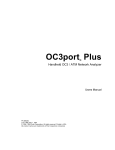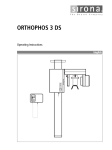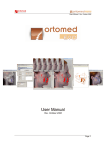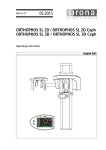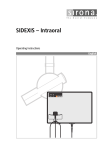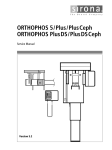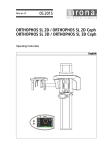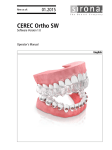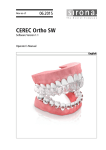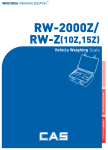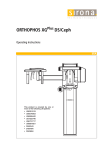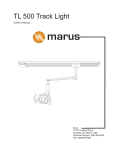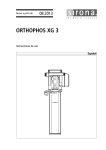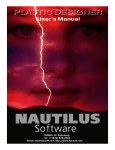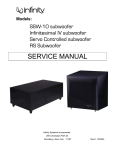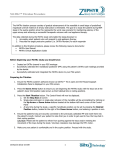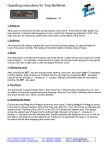Download 368,34,37 4PYW (7
Transcript
368,34,37 4PYW (7 3TIVEXMRK-RWXVYGXMSRW )RKPMWL General information n Sirona Dental Systems GmbH General information Dear Customer Thank you for purchasing your new ORTHOPHOS Plus DS X-ray unit for panorama planigraphy. Standard radiographs (jaw region), sinus radiographs (maxillary sinuses) and temporomandibular joint radiographs in digital exposure technique are possible. For this unit we have provided you with a set of technical literature. Keep this literature for quick and easy reference. In order to protect your rights under Sirona warranty, the purchaser must register the unit by filling out the Warranty Passport provided together with the technician immediately after installation of the unit. Read the Operating Instructions to familiarize yourself with the unit before taking radiographs on the patient. Please observe the Radiation Protection Regulations and Warning Notes. These Operating Instructions assume a thorough familiarity with the SIDEXIS software. Your ORTHOPHOS Team Maintenance To ensure the safety of the patient, the operators and third parties, equipment inspections and maintenance work must be carried out at specified intervals in order to guarantee the operational safety and functional reliability of your product. It is the responsibility of the operator to ensure that the inspections and maintenance work are carried out. In the event that the operator fails to fulfil the obligation to carry out inspections and maintenance work or ignores error messages, Sirona Dental Systems GmbH or their contracted dealer cannot assume liability for any damage attributable to this. 2 41 62 769 D3297 D3297.201.03.19.02 Sirona Dental Systems GmbH 1 2 3 List of Contents Warning and Safety Notes.......................................................................................... 5 Technical Description ................................................................................................. 7 Operating Controls and Displays .............................................................................. 11 3.1 3.2 3.3 3.4 4 11 11 12 12 Accessories ................................................................................................................. 13 4.1 4.2 4.3 5 Unit ................................................................................................................................................... Control Panel A................................................................................................................................. Help LED-displays ............................................................................................................................ Multitimer .......................................................................................................................................... Rests and supports........................................................................................................................... 13 Hygienic Protective Covers............................................................................................................... 14 Service Tools .................................................................................................................................... 14 Exposure Programs .................................................................................................... 15 5.1 5.2 5.3 5.4 5.5 5.6 5.7 5.8 5.9 5.10 5.11 5.12 5.13 5.14 5.15 5.16 41 62 769 D3297 D3297.201.03.19.02 P 1 Program...................................................................................................................................... P 2 Program...................................................................................................................................... P 3 Program...................................................................................................................................... P 4 Program...................................................................................................................................... P 5 Program...................................................................................................................................... P 6.1 / P 6.2 Program ....................................................................................................................... P 7.1 / P 7.2 Program ....................................................................................................................... P 8 Program...................................................................................................................................... P 9 Program...................................................................................................................................... P 10 Program.................................................................................................................................... P 11 Program.................................................................................................................................... P 12 Program.................................................................................................................................... P 13 Program.................................................................................................................................... P 14 Program.................................................................................................................................... P 15 Program.................................................................................................................................... P 16 Program.................................................................................................................................... 15 15 16 16 17 17 18 18 19 19 20 20 21 21 22 22 3 )RKPMWL n List of Contents List of Contents 6 Operating ..................................................................................................................... 23 6.1 6.2 6.3 6.4 7 Sirona Dental Systems GmbH Preparing the Exposure ................................................................................................................... 23 Insert Accessories ..................................................... 23 Contact Spacer and Head Positioner ........................ 23 Switching ON the Unit ............................................... 24 Switching ON the PC ................................................. 24 Primary Diaphragm ................................................... 24 Digital Displays .......................................................... 25 Positioning the Patient ..................................................................................................................... 26 Preparations .............................................................. 26 Exposure with Chin Rest and Bite Block ................... 26 The Frankfurt horizontal FH ...................................... 28 Digital displays .......................................................... 28 Exposure with Chin Rest and Bar ............................. 29 Exposure with Bite Block or Contact Segment without Chin Support ............................................................. 30 . . with Bite Block ....................................................... 30 . . . with Contact Segment ......................................... 30 The Frankfurt Horizontal FH ................................... 31 Digital displays ........................................................ 31 Exposures of the Temporomandibular Joint, P4 – P9 Programs with Head Positioner ................................. 32 Final Preparations ............................................................................................................................ 33 Selecting the Exposure Program ............................... 33 Exposure Data ........................................................... 34 Anomaly Button A ...................................................... 34 Releasing the Exposure ................................................................................................................... 36 Interrupting the Exposure .......................................... 37 Automatic Exposure Blockage .................................. 37 Error Message E... .................................................... 38 Programming............................................................................................................... 39 Programming Procedure ........................................... 39 Adjustment of the Exposure ...................................... 39 8 9 Help Messages H3/H4 ................................................................................................. 40 Program Values........................................................................................................... 41 9.1 9.2 9.3 10 11 12 4 Program Values for Code 2A ........................................................................................................... 41 Program Values for Code 4A ........................................................................................................... 42 Program Values for Code 1A ........................................................................................................... 43 Care the surfaces ........................................................................................................ 44 List of Error Messages ............................................................................................... 45 Inspection and Maintenance ...................................................................................... 47 41 62 769 D3297 D3297.201.03.19.02 Sirona Dental Systems GmbH 1 1 Warning and Safety Notes Warning and Safety Notes Labeling of warning and safety information In order to prevent injury to persons and damage to the equipment you must also read the warning and safety notes given in these Operating Instructions. These are emphasized with ATTENTION and CAUTION. Intended use This unit has been designed for use in creating panorama radiographic exposures. General safety information As manufacturers of electro-medical products, we can assume responsibility for safety-related performance of the equipment only if maintenance, repair and modifications are carried out only by us or agencies we have authorized for this purpose, and if components affecting safe operation of the unit that may be needed are replaced with original parts. We suggest that you request a certificate showing the nature and extent of the work performed, from those who carry out such work, and specify that the certificate show any changes in rated parameters or working ranges, as well as the date, the name of the firm, and a signature. For reasons of product safety, only original Sirona accessories approved for this product, or accessories from third parties which have been released by Sirona may be used. It is the user’s risk when using nonreleased accessories. Exposures of patients may only be taken if the unit functions fault-free. Never leave the patient unattended in the unit. Instructions for avoiding, recognizing and correcting unintended electromagnetic effects: The ORTHOPHOS Plus DS X-ray System is a unit of class A (classification according to CISPR 11, EN 60601-1-2: 1993 based off IEC 60601-1-2). This unit may be operated in a residential area, provided it is used under the responsibility of a trained medical operator. Safety measures during switch-on Following extreme temperature fluctuations, condensate formation may occur; therefore please do not switch on the device until normal room temperature has been reached (see chapter "Technical Description"). When switching on the unit, there must not be a patient positioned in the unit. If a fault occurs which requires switching the unit off and then back on again, the patient must be taken out of the unit at the latest before switching it on again! 41 62 769 D3297 D3297.201.03.19.02 5 )RKPMWL This unit must not be used in areas where there is a risk of explosion. 1 Warning and Safety Notes Sirona Dental Systems GmbH Interference with electromedical devices by radio telephones To guarantee the operational safety of electromedical devices, it is recommended that the operation of mobile radio telephones in the medical practice or hospital is prohibited. Malfunction of electronic units/devices which are worn on the patient’s body. In order to prevent failure of electronic units and data storage devices, e.g. radio-controlled watch and telephone card, etc., it is essential that these be removed prior to X-ray exposure. Radiation Protection Observe the applicable health physics regulations.The radiation protection facilities should be used. The operator should remain as far away from the X-ray tube as the cable of the release button permits. With the exception of the patient, no other persons may remain in the room while the exposure is being made. Under exceptional circumstances a third person, however not belonging to the dental practice, may then assist. Maintain visual contact with the patient and the unit during the exposure. In case of faulty operation, discontinue the exposure by releasing the exposure button. Disassembly and reinstallation For disassembly and reinstallation of the unit proceed as described in the installation instructions for new installation to ensure perfect function of the unit and its stability. Disposal This product’s X-ray tube assembly includes a tube capable of implosion, a small amount of beryllium, a lead housing and mineral oil. Make certain you observe the appropriate legal regulations when disposing of this product or parts thereof. 6 41 62 769 D3297 D3297.201.03.19.02 Sirona Dental Systems GmbH Technical Description Nominal line voltage: Permissible fluctuation 208V / 230V AC with 230 V: with 208 V: +6, –10% ±10% Nominal current: 12A Nominal frequency: 50/60 Hz Power line resistance: max. 0,8 Ohm Fuse at the distribution panel: 16 A slow blow Rating: 2,8kVA Tube voltage: 60 – 90 kV Tube current: 9 –16mA Curve form of high voltage: high frequency, multipulse Residual ripple ≤ 4kV )RKPMWL 2 2 Technical Description Filament Nominal current: 3,0V – 7.5V Nominal current: 3,0A – 4.2V Nominal frequency: DC Duty cycle: 1:20 Program duration: see page 41 Exposure time: see page 41 Reproduction scale: With P1 program, medium mandibular arch (plane center) ca. 1:1,19. The image at the image receiver is approximately 19% larger than the real proportions. Focus size, according to IEC 336, measured in central ray: 0,5mm Focus marking: Automatic exposure blockage (see page 37): The duration of the exposure blockage (cool-off period) depends on the kV/mA step set and the actually triggered radiation time. Depending on the tube load, pause times between 8s and 300s are set automatically. Example: For P1 program with exposure data 80kV/14mA and a radiation time of 14.1s a pause of 255s results. Equipment of protective class I Protection against electric shock: Type B equipment Protection against penetration of water: Ordinary equipment (without protection) 41 62 769 D3297 D3297.201.03.19.02 7 2 Technical Description Sirona Dental Systems GmbH Mode of operation: Continuous operation Long time power rating 60W Target material Wolfram Loading factors concerning leakage radiation 0,57mA / 90kV Source - Image receptor distance 497 mm Transport and storing temperature: -40°C – +70°C (-40°F – 158°F) Permissible operating temperature: According to IEC 601-1 between +10°C and +40°C (50°F – 104°F) Relative humidity: 10% – 95% Sensor (image receptor): Type: Digital CCD-technology line sensor, can be plugged to Panorama or Ceph radiography position. External dimensions: 280mm x 120mm x 35mm Active sensor surface: Panorama: 138 x 5.9mm Resulting image format: Panorama: depends on selected program, max. 138 x 288mm Detail recognition: Panorama: 0.09mm pixel size Minimum requirements for the PC systems Hard disk: > 2 GByte / database > 50 MByte / SIDEXIS installation RAM: at least 64 MB Drives: CD-ROM 3.5" diskette (one per system / network) MOD drive min. 640 MByte (one per system / network) Operating system: Windows 98 Windows NT 4.0 / Service Pack > 5 Graphics system: Resolution at least 1024 x 768 pixels, color depth at least 8 bit Network: 10 / 100 MBit Ethernet Communication connection: RJ45 for LAN cable ORTHOPHOS Plus DS is in compliance with IEC 601-2-28 / 1993 ORTHOPHOS Plus DS is in compliance with IEC 601-1-3 / 1994 Original language: german This product is provided with a CE marking in accordance with the regulations stated in the Directive 93/42/ EEC of June 14, 1993 concerning medical products. 0123 8 41 62 769 D3297 D3297.201.03.19.02 Sirona Dental Systems GmbH 2 Technical Description Reference axis / Anode angle Reference axis 7° ± 1° 10° ± 1° Anode angle )RKPMWL 324 216 Sizes and weight 226 193 274,5 125,5 no true sclae approx. length values weight: approx. 16kg Cooling curve for the tube housing: HUx104 1HU = 1,35 Joule 130 120 110 100 90 80 70 60 50 40 30 20 10 t 0 60 41 62 769 D3297 D3297.201.03.19.02 120 180 240 300 360 420 480 540 600 660 720 min 9 2 Technical Description Sirona Dental Systems GmbH Anode cooling caracteristic: HUx103 25 1HU = 1,35 Joule 20 15 10 5 t 0 1 2 3 4 5 6 min Heating curve for tube housing: HUx103 1HU = 1,35 Joule 1350 t 0 10 1 2 3 4 5 6 h 41 62 769 D3297 D3297.201.03.19.02 Sirona Dental Systems GmbH 3 1 Operating Controls and Displays Unit 2 3 4 5 6 78 1 Main switch 2 Patient positioning mirror 3 Height adjustment for the FH light line 4 Adjusting knob for temple supports 5 Forehead support 6 Temple supports 7 Image receiver 8 Knob for image receiver removal or insertion 9 Button for removing bite block )RKPMWL 3.1 3 Operating Controls and Displays 10 Diaphragm wheel 11 Locking button for diaphragm wheel 12 Primary diaphragm 9 1011 12 A Multitimer 3.2 Control Panel A Return button R Light localizer ON / OFF Anomaly button A + – with LED display Height adjustment display in mm Height adjustment Forehead support adjustment display in mm Forehead support adjustment ← towards column / away from column → 41 62 769 D3297 D3297.201.03.19.02 11 3 Operating Controls and Displays 3.3 Sirona Dental Systems GmbH Help LED-displays See the inside of the door for a list of appropriate H3/H4 help messages (see page 40). 13 16 14 Forehead support position 14 15 13 SIDEXIS exposure stand-by 17 18 15 Image receiver slot 16 X-ray tube position 17 Cool-down interval 18 Diaphragm adjustment 19 3.4 19 Height adjustment Multitimer ”Unit ON” LED X-ray ON indicator P I 62 8 Exposure button P I I4.I 62 8 Digital display for exposure program / exposure time with – + buttons for exposure programs Digital display for kV/mA values with – + buttons for kV/mA matched values Patient symbols programmed kV/mA values Memory program button kV/mA matched values Button with Service function Rotation test button T without radiation Return button R The LED blinks when the system is not ready (Ready-LED). 12 41 62 769 D3297 D3297.201.03.19.02 Sirona Dental Systems GmbH 4 4.1 4 Accessories Accessories Rests and supports The receptacles behind the door are for the storage of accessories and hygienic protective covers. Press shortly to open.. Handles and * marked accessories can be sterilized. Sterilize only in an autoclave at 135°C, 2.1 bar (275°F, 30PSI). Untightened handles can be removed for sterilization as shown. For tightened handles, please use the hygienic protective covers shown on the next page. For reorders: 135°C 275°F E* )RKPMWL A* Forehead support strip (5 pcs) Order No. 89 21 835 B* Chin rest complete, incl. 5xE, 1xF, C, D, R, S Order No. 18 88 762 C* Bar for chin rest Order No. 59 61 461 D* Intermediate piece Order No. 14 49 227 E* Bite block (10 pcs) A* C* F F Order No. 18 88 887 Stick for bite block (5 pcs) Order No. 18 88 895 G* Standard yellow bite block (5 pcs) Order No. 89 21 843 D* H* Standard yellow contact segment for subnasals (5 pcs) Order No. 89 31 545 H* J B* G* L Head positioner complete, incl. 4xK Order No. 18 88 770 K* Ear fixation (10 pcs) L Order No. 18 88 838 Contact spacer Order No. 33 10 336 M* Bite block blue, for sinus exposures (5 pcs) Order No. 89 21 850 J N* N* Contact segment, blue, for subnasals with sinus and paranasal tomographic exposures (5 pcs) Order No. 89 31 552 M* K* 41 62 769 D3297 D3297.201.03.19.02 13 4 Accessories 4.2 Sirona Dental Systems GmbH Hygienic Protective Covers Before each exposure, the hygienic protective covers (disposable) should be attached. For better illustration of the components, the following figures are shown without the hygienic protective covers. For orders: P P For forehead support and handles (500 pcs) Order No. 33 14 098 Dimensions: 210mm (140mm) x 57 mm R For chin rest (100 pcs) Order No. 59 32 603 Dimensions: 75mm x 60mm S For bite block (500 pcs) Order No. 33 14 072 Dimensions: 43mm x 21mm T For bite block and contact segment (500 pcs) Order No. 33 14 080 Dimensions: 80mm x 40mm S R T 4.3 Service Tools Tools supplied with the unit and needed for the maintenance and/or service must remain with the unit. (Adjustment set). 1 2 1 Special wrench Order No. 52 43 605 2 Needle phantom Order No. 89 31 925 3 Test block 3 14 41 62 769 D3297 D3297.201.03.19.02 Sirona Dental Systems GmbH 5 5.1 5 Exposure Programs Exposure Programs P 1 Program Complete standard exposure 1 CCD PAN 10 0,59x13,84cm CCD Ceph 0,59x18,40cm • Chin support with rod and bite block or bar or yellow bite block or contact segment. • Working area forehead support 00.0 - 30.0 Head inclination with FH. • Automatic selection of section shape via temple support setting for different mandibular arches. Radiation time dependent on adjusted width of temple supports. • Manual compensation for anatomical relationships (protrusion, retrusion) by anomaly button A (see page 34). PAN SID = 49,7cm yellow 5.2 P 2 Program Standard exposure, restricted to the teeth (without ascending branches). 2 10 CCD PAN 10 0,59x13,84cm CCD Ceph 0,59x18,40cm PAN SID = 49,7cm • Chin support with rod and bite block or bar or yellow bite block or contact segment. • Working area forehead support 00.0 - 30.0 Head inclination with FH. • Automatic selection of section shape via temple support setting for different mandibular arches. Radiation time dependent on adjusted width of temple supports. • Manual compensation for the anatomical relationships (protrusion, retrusion) by anomaly button A (see page 34). yellow 41 62 769 D3297 D3297.201.03.19.02 15 )RKPMWL 10 5 Exposure Programs 5.3 Sirona Dental Systems GmbH P 3 Program Sinus maxillaris (2-on-1 image subdivision) 3 10 • Blue bite block or contact segment. • Forehead support strip with attachment down (see page 23). • Working area forehead support 10.0 - 30.0 Head inclination with FH. • Only release trigger when Ready-LED flashes. (radiation is released automatically twice in a row). CCD PAN 10 0,59x13,84cm CCD Ceph 0,59x18,40cm PAN SID = 49,7cm blue 5.4 P 4 Program Lateral exposure of the temporomandibular joints (ascending branches) 4 6 10 • Insert head positioner (see page 23). • Working area forehead support 06.0 - 30.0 Recommended position of forehead support 06.0. Head inclination with the aid of FH. CCD PAN 10 0,59x13,84cm CCD Ceph 0,59x18,40cm PAN SID = 49,7cm Head positioner 16 41 62 769 D3297 D3297.201.03.19.02 Sirona Dental Systems GmbH 5.5 5 Exposure Programs P 5 Program Posterior/anterior exposures of the temporomandibular joints 5 20 10 • Insert head positioner (see page 23) • Working area forehead support 00.0 - 27.0 Recommended position of forehead support 20.0 To avoid superimpositions to a large extent, head inclination relative to FH toward anterior. CCD PAN 10 0,59x13,84cm CCD Ceph 0,59x18,40cm )RKPMWL PAN SID = 49,7cm Head positioner 5.6 P 6.1 / P 6.2 Program Lateral exposures of the temporomandibular joints with closed and open mouth. (4 exposures on 1 image) 6 6 10 P6.1 P6.2 P6.2 P6.1 CCD PAN 10 0,59x13,84cm CCD Ceph 0,59x18,40cm PAN SID = 49,7cm P6.1 Head positioner • Insert head positioner (see page 23). • Working area forehead support 00.0 - 30.0 Recommended position of forehead support 06.0 Head inclination with the aid of FH. P 6.1 Outer Image: Closed mouth P 6.2 Inner Image: Open mouth • Actuate P6.1 After P 6.1 is completed, the unit automatically returns to the initial position. • Have the patient open his mouth and actuate P6.2. P6.2 41 62 769 D3297 D3297.201.03.19.02 17 5 Exposure Programs 5.7 Sirona Dental Systems GmbH P 7.1 / P 7.2 Program Posterior/anterior exposures of the temporomandibular joints with closed and open mouth. (4 exposures on 1 image) 7 20 10 P7.1 P7.2 P7.2 • Insert head positioner (see page 23) • Working area forehead support 00.0 - 27.0 Recommended position of the forehead support 20.0 To avoid superimpositions to a large extent, head inclination relative to FH toward anterior. P7.1 P 7.1 Outer Image: Closed mouth P 7.2 Inner Image: Open mouth P7.1 Head positioner • Actuate P 7.1. After P7.1 is completed, the unit automatically returns to the initial position. • Have the patient open his mouth and actuate P 7.2. P7.2 5.8 P 8 Program Multi-layer exposures, lateral exposures of the temporomandibular joints (6 exposures on 1 image) 8 0 10 A B C C B A • Insert head pointer (see page 23) • Working area forehead support 00.0 - 30.0 Recommended position of the forehead support 00.0 Head inclination with the aid of FH. CCD PAN 10 0,59x13,84cm CCD Ceph 0,59x18,40cm CBA PAN SID = 49,7cm Head positioner 18 41 62 769 D3297 D3297.201.03.19.02 Sirona Dental Systems GmbH 5.9 5 Exposure Programs P 9 Program Multi-layer exposures, posterior/anterior exposures of the temporomandibular joints. (6 exposures on 1 image) 9 20 10 B C C B A C B A Insert head positioner (see page 23) • Working area forehead support 00.0 - 27.0 Recommended position of forehead support 20.0 To avoid superimpositions to a large extent, head inclination relative to FH toward anterior CCD PAN 10 0,59x13,84cm CCD Ceph 0,59x18,40cm )RKPMWL A • PAN SID = 49,7cm Head positioner 5.10 P 10 Program Standard exposure (Status), preferred mode for children 10 2 • IMPORTANT! Adjust diaphragm 2. CCD PAN 2 0,59x13,84cm CCD Ceph 0,59x18,40cm • Yellow bite block or contact segment. • Working area forehead support 00.0 - 30.0 Head inclination with the aid of FH. • Automatic selection of section shape via temple support setting for different mandibular arches. Radiation time dependent on adjusted width of temple supports. • Manual compensation for anatomical relationships (protrusion, retrusion) by anomaly button A (see page 34). PAN SID = 49,7cm yellow 41 62 769 D3297 D3297.201.03.19.02 19 5 Exposure Programs 5.11 Sirona Dental Systems GmbH P 11 Program with constant 1.25-fold magnification, e.g. for implantology 11 10 CCD PAN 10 0,59x13,84cm CCD Ceph 0,59x18,40cm PAN • Chin support with rod and bite block or bar or yellow bite block or contact segment. • Working area forehead support 00.0 - 30.0 Head inclination with the aid of FH. • Automatic selection of section shape via temple support setting for different mandibular arches. Radiation time dependent on adjusted width of temple supports. • Manual compensation for anatomical relationships (protrusion, retrusion) by anomaly button A (see page 34). SID = 49,7cm yellow 5.12 P 12 Program Display of the anterior teeth area with larger section thickness e.g. for implantology 12 10 • Chin support with rod and bite block or bar or yellow bite block or contact segment. • Working area forehead support 00.0 - 27.0 Head inclination with the aid of FH. CCD PAN 10 0,59x13,84cm CCD Ceph 0,59x18,40cm PAN SID = 49,7cm yellow 20 41 62 769 D3297 D3297.201.03.19.02 Sirona Dental Systems GmbH 5.13 5 Exposure Programs P 13 Program Paranasal tomographic exposures e.g. blow-out fractures 13 10 • Blue contact segment insert subnasal (see page 30) • Insert head positioner without ear fixation (see page 23) • Working area forehead support 00.0 - 30.0 Patient head max. reclined. CCD PAN 10 0,59x13,84cm CCD Ceph 0,59x18,40cm PAN )RKPMWL SID = 49,7cm blue head positioner 5.14 P 14 Program Standard exposure, left half side 14 10 CCD PAN 10 0,59x13,84cm CCD Ceph 0,59x18,40cm PAN • Chin support with rod and bite block or bar or yellow bite block or contact segment. • Working area forehead support 00.0 - 30.0 Head inclination with the aid of FH. • Automatic selection of section shape via temple support setting for different mandibular arches. Radiation time dependent on adjusted width of temple supports. • Manual compensation for anatomical relationships (protrusion, retrusion) by anomaly button A (see page 34). SID = 49,7cm yellow 41 62 769 D3297 D3297.201.03.19.02 21 5 Exposure Programs 5.15 Sirona Dental Systems GmbH P 15 Program Standard exposure, right half side 15 10 CCD PAN 10 0,59x13,84cm CCD Ceph 0,59x18,40cm • Chin support with rod and bite block or bar or yellow bite block or contact segment. • Working area forehead support 00.0 - 30.0 Head inclination with the aid of FH. • Automatic selection of section shape via temple support setting for different mandibular arches. Radiation time dependent on adjusted width of temple supports. • Manual compensation for anatomical relationships (protrusion, retrusion) by anomaly button A (see page 34). PAN SID = 49,7cm yellow 5.16 P 16 Program Multi-layer exposures in the buccal teeth area (6 exposures on 1 image) 16 10 C B A C B A 22 A B C • Yellow bite block or contact segment. • Working area forehead support 05.0 - 30.0 • Mandibular margin horizontally. CCD PAN 10 0,59x13,84cm CCD Ceph 0,59x18,40cm PAN SID = 49,7cm yellow 41 62 769 D3297 D3297.201.03.19.02 Sirona Dental Systems GmbH 6 6.1 6 Operating Operating Preparing the Exposure Insert Accessories A • Insert Chin Rest or Bite Block up to stop. For application see chapter ”Exposure Programs”. 4 • Press button (9) to remove. • Open Temple Supports with button (4). • with attachment A ↑ up for adults. • with attachment A ↓ down for patients with smaller heads. 9 Contact Spacer and Head Positioner • Insert Contact Spacer L Application for temporomandibular jaw exposure programs P4 – P9. Always place the contact spacer where, as a result of anatomical features, with correct head positioning there is no contact with the forehead (no 3-point fixing). • After positioning the head, press the contact spacer onto the tube and push it down to the forehead contact. • Insert Head Positioner J • Open temple supports, • Insert head positioner up to stop. Application for temporomandibular jaw exposure programs P4–P9 and for paranasal tomography P13, but without ear fixation. 41 62 769 D3297 D3297.201.03.19.02 23 )RKPMWL Insert Forehead Support Strip A A 6 Operating Sirona Dental Systems GmbH Switching ON the Unit ATTENTION Following extreme temperature fluctuations, condensate formation may occur; therefore please do not switch on the device until normal room temperature has been reached (see chapter "Technical Description"). • Depress the main switch (1) into the I position and wait 1 minute. • The LED in the upper left corner of the Multitimer will light up. • The unit adjusts itself automatically: • The rotating unit moves a little to the right and left. • The forehead support moves to basic position 10.0. ATTENTION When switching on the unit, there must not be a patient positioned in the unit. If a fault occurs which requires switching the unit off and then back on again, the patient must be taken out of the unit at the latest before switching it on again! Switching ON the PC • 13 Prepare SIDEXIS program on PC for ORTHOPHOS Plus DS (XP) exposure stand-by (see SIDEXIS User’s Manual). Help LED (13) for SIDEXIS exposure stand-by in Control Panel A extinguishes. Primary Diaphragm Depending on the exposure program selected, diaphragm 10 or 2 is required. Diaphragm 2 is preferred for children. Adjust diaphragm by pressing button (11) and rotating the diaphragm wheel (10) up to the stop. The diaphragm number appears in the upper right corner of the window. When the diaphragm moved into place is not suitable for the program preselected on the Multitimer or when the diaphragm is not correctly locked into place, Help LED (18) for diaphragm setting flashes on control panel A. 11 10 18 24 Lock correct diaphragm into place, the LED (18) extinguishes. 41 62 769 D3297 D3297.201.03.19.02 Sirona Dental Systems GmbH 6 Operating Digital Displays 493 At the control panel A I0.0 • The mm value of height adjustment between 000 and 640 from the last patient. • The basic forehead support value of 10.0 mm. • or a help message H3... or an error message E... is displayed, same as on the Multitimer (see page 40 and 45). Multitimer Exposure key A B P I 62 8 A shows you the exposure program sequentially and the respective maximum exposure time. B gives you the kV/mA matched value pair. The LED over the respective patient symbol lights up. C The LED over the return button R blinks. Move the rotating unit into place for patient positioning by tapping one of the return buttons R. Help LED (16) for the tube unit position extinguishes on control panel A. L NOTE You can release a test rotation without radiation via the exposure button after having pressed the T button. C 16 41 62 769 D3297 D3297.201.03.19.02 25 )RKPMWL At the Multitimer the program and exposure parameters employed with the last patient appear. 6 Operating 6.2 Sirona Dental Systems GmbH Positioning the Patient Preparations • Have the patient remove all metallic objects such as glasses and jewelry, from the head and neck regions. Have him take out removable dentures. • Physical constitution, clothing, bandages etc. must not interfere with the functioning of the unit! Perform a test run with the T button (see page 25). • Insert chin rest, bite block/contact segment or head positioner, see ”Exposure Programs” chapter. Exposure with Chin Rest and Bite Block • With programs P1, P2, P10, P11, P12, P14 and P15, move forehead support to the 00.0 position by actuating the ← key. For the forehead support setting for the other programs refer to the ”Exposure Programs” chapter”. • Have the patient stand in front of the mirror. • Using the ↑ and ↓ buttons, adjust unit height so that the chin of the patient and the chin rest match up. Motoric movement is accompanied by an acoustic signal. L NOTE The height adjustment motor starts up slowly and then picks up speed. 26 • Have the patient place his chin on the chin rest and grip the handles. • Swing in the bite block. • Have the patient bite the bite block at the indentation (the upper anterior teeth should be directly in the indentation, and the lower anterior teeth should be moved forward up to the stop). 41 62 769 D3297 D3297.201.03.19.02 Sirona Dental Systems GmbH 6 Operating ATTENTION Make certain the spine is tilted slightly as shown. This moves the patient’s cervical vertebrae into a more stretched out position. The cervical vertebrae ”stretched out” ensures that the area of the anterior teeth is not over exposed. In special cases, it is also possible to position for sitting patients. )RKPMWL CORRECT INCORRECT 41 62 769 D3297 D3297.201.03.19.02 27 6 Operating Sirona Dental Systems GmbH • Swing out the mirror by pressing on field A. • Position the patient's head so that the biting surface is slightly tilted forward. • Switch on the light localizer by pressing the key on the control panel. The light localizer facilitates correct positioning of the patient. L NOTE The light localizer turns off automatically after about 2,5 minutes. B The Frankfurt horizontal FH light beam should reflect from the plane passing through the lower margins of the orbits and the upper margins of the external auditory orifices. 3 A The knob (3) can be used to vertically adjust the FH line. 5 4 6 )+ • Finely adjust the head inclination for the FH line adjustment by tapping the buttons ↑ or ↓ for vertical unit movement. • Line up the middle of the patient's face with the central light line. • Press the → button for movement away from the column until the forehead support (5) touches the patient's forehead. L NOTE When the temple support position is not suitable for the preselected exposure program, Help LED (14) flashes. Run the temple support into the correct position (see exposure programs), LED (14) extinguishes. • Position the temple supports (6) firmly with knob (4). L 5 4 NOTE With programs P1, P2, P10, P11, P14 and P15, the radiation time changes as a function of the width of the temple supports. 6 14 • Swing back the mirror by pressing on field B. • Have the patient take a small step toward the column. Recheck the FH-line position. • Have patient press tongue against roof of palate. Digital displays The reference values for height and forehead support are displayed on the control panel. 28 41 62 769 D3297 D3297.201.03.19.02 Sirona Dental Systems GmbH 6 Operating Exposure with Chin Rest and Bar • Remove bite block with holding rod and insert bar as shown (bow facing column). • Ensure that the upper and lower jaws are lined up with each other. This is facilitated by a cotton roll. • Proceed as in the case of exposures with chin rest and bite block. Deviation: The patient places his chin on the chin rest. 41 62 769 D3297 D3297.201.03.19.02 • To position the head optimally for tomographic exposures, the bar should be just under the patient's nose. • If there are still anterior teeth in the lower jaw, place the bar between chin and lower lip. • Have patient press tongue against roof of palate. 29 )RKPMWL For patients without anterior teeth 6 Operating Sirona Dental Systems GmbH Exposure with Bite Block or Contact Segment without Chin Support • With programs P1, P10, P14 and P15, move the forehead support to the 00.0 position by actuating the ← key. For the forehead support setting for the other programs refer to the ”Exposure Programs” chapter. • Have the patient stand in front of the mirror. . . with Bite Block • Using the ↑ and ↓ buttons, adjust unit height so that the bite block and the anterior teeth match up. • Have the patient grip the handles. • Have the patient bite the bite block at the indentation. The upper anterior teeth should be directly in the indentation, and the lower anterior teeth should be moved forward up to the stop. . . . with Contact Segment For patients without anterior teeth 30 • Adjust the unit height so that contact segment and subnasals match up. • The contact segment should be just under the patient's nose. Ensure that the upper and lower jaws are lined up with each other. This is facilitated by a cotton roll. • Ensure that the spine is slightly tilted as described before. 41 62 769 D3297 D3297.201.03.19.02 Sirona Dental Systems GmbH 6 Operating • Swing out the mirror by pressing on field A. • Position the patient's head so that the biting surface is slightly tilted forward. • Switch on the light localizer by pressing the key on the control panel. The light localizer facilitates correct positioning of the patient. L NOTE The light localizer turns off automatically after about 2,5 minutes. B 3 The Frankfurt Horizontal FH light beam should reflect from the plane passing through the lower margins of the orbits and the upper margins of the external auditory orifices. A 5 4 • Finely adjust the head inclination for the FH line adjustment by tapping the buttons ↑ or ↓ for vertical unit movement. • Line up the middle of the patient's face with the central light line. • Press the → button for movement away from the column until the forehead support (5) touches the patient's forehead. 6 L NOTE When the temple support position is not suitable for the preselected exposure program, Help LED (14) flashes. Run the temple support into the correct position (see exposure programs), LED (14) extinguishes. • Position the temple supports (6) firmly with knob (4). L NOTE With programs P1, P10, P14 and P15, the radiation time changes as a function of the width of the temple supports. 5 4 • Swing back the mirror by pressing on field B. • Have the patient take a small step toward the column. Recheck the FH-line position. • Have patient press tongue against roof of palate. 6 14 Digital displays The reference values for height and forehead support are displayed on the control panel. 41 62 769 D3297 D3297.201.03.19.02 31 )RKPMWL The knob (3) can be used to vertically adjust the FH line. 6 Operating Sirona Dental Systems GmbH Exposures of the Temporomandibular Joint, P4 – P9 Programs with Head Positioner • For these exposures the head positioner must be used (see page 23). • Using the ↑ and ↓ keys, adjust unit height so that ear fixations and external auditory canals match up. • Remove chin support and bite block. • Move the chin support to the value indicated for the respective mandibular joint exposure under ”Exposure Programs”. • Position the patient's head in the head positioner. Close the temple supports so that the ear fixations are inserted in the external auditory canals. • Ensure that the spine is slightly tilted as described before (Have the patient take a small step toward the column). • Swing out the mirror. • Switch on the light localizer to set the correct position. Press the key on the control panel. • Clip contact spacer L onto the tube after head positioning and push downwards to support forehead The Frankfurt Horizontal FH light beam should reflect the plane passing through the upper margins of the ear fixation and the lower margins of the orbits.* The FH line can be vertically adjusted with the knob (3) • * 32 Swing back the mirror. In case of the temporomandibular exposure programs P5, P7 and P9, the head setting deviates from the FH, see the ”Exposure Programs” chapter. 41 62 769 D3297 D3297.201.03.19.02 Sirona Dental Systems GmbH 6.3 6 Operating Final Preparations • Switch off the light localizer at the control panel. • The image receiver (7) must be pushed all the way to the stop. L NOTE To remove the image receiver, turn the rotary knob (8) and pull the image receiver out. 8 7 ATTENTION Do not drop it! The LED above the R-key on the Multitimer is now switched off to let you know that the unit is ready for the exposure. ATTENTION IMPORTANT REMARK: Should the LED above the R-key go on blinking, call up the help message H3.. H4.. to look for the reason (Press release key). The list of help messages you find at the inside of the door. H3.../ H4... 15 Selecting the Exposure Program Selecting the Exposure Program by pressing the – + buttons. I4.I 41 62 769 D3297 D3297.201.03.19.02 P I 62 8 manuall The exposure program selected, e.g. P1, and the corresponding maximum exposure time are alternatively shown on the digital display. L NOTE When, with preselection of the exposure program, “O 1” appears on the display instead of, for example, “P 1”, you have erroneously selected a mode provided for servicing. You can leave this mode by pressing the ”Memory” button and then ”Program +” or by switching to another exposure program. 33 )RKPMWL When the image receiver (7) is not inserted up to the stop, Help LED (15) flashes. Insert the image receiver completely, LED (15) extinguishes. 6 Operating Sirona Dental Systems GmbH Exposure Data • Select Exposure Data by tapping one of the four patient symbol buttons. The LED above the button will then light up, and the respective kV/mA matched pair will appear on the digital display. P I 62 8 Manually, the exposure data can be modified with the – + buttons. manuall The mA values are automatically matched to the kV values. (See chapter ”Program Values”). The kV/mA matched values for the patient symbol buttons are factory programmed. Should you need to modify these values, see the chapter entitled ”Programming”. Anomaly Button A The Anomaly Button A is for manual compensation of anatomical relationships in the case of anomalies of the anterior teeth with the P1, P2, P10, P11, P14 and P15 programs. In case of retrusion: move one step in + direction In case of protrusion: move a step or two in – direction The setting is shown by means of an LED. After the rotary unit returns to its original position following the exposure, the settings automatically return to those of normal jaws (2nd LED from the left/Asia: 3rd LED from the left). 493 34 41 62 769 D3297 D3297.201.03.19.02 Sirona Dental Systems GmbH 6 Operating L NOTE It is possible to set the Anomaly step, which as a rule is set to "0" (neutral) before every exposure, to another standard value (+1; -1; -2). Proceed as follows: 1. P I 62 8 1. Select program P1. For the basic Anomaly setting, the 2nd LED from the left (Asia: 3rd LED from the left) lights up. 2. Press the Test Rotation key T . The LED above the T key lights up.. 3. Press the Memory key. 4. 3. On the control panel at the side, select the required new standard Anomaly step. About 5 seconds after letting go of the Anomaly key, the LED for the pre-selected Anomaly step flashes for about 1 second. 2. / 5. The Anomaly LED then remains lit up. The Anomaly step is stored. 5. 41 62 769 D3297 D3297.201.03.19.02 Press the Test Rotation key T . 35 )RKPMWL The LED above the Memory key begins flashing. 6 Operating 6.4 Sirona Dental Systems GmbH Releasing the Exposure Observe the radiation protection guidelines explained on page 5. L NOTE The Help LEDs on the bottom of Control Panel A must all be extinguished and the Ready LED may no longer be flashing! • The exposure is released by keeping depressed the release button. The rotation movement is running automatically in accordance with the exposure program selected. A For P6 and P7 program only The rotary unit moves back into the starting position after having completed the program parts P6.1 (P7.1). Then have the patient open his mouth and release the program part P6.2 (P7.2). During radiation, the radiation indicator X-ray lights up. The radiation duration is additionally accompanied by an acoustic signal. • The exposure ends when the LED over button R blinks. Rotation and radiation automatically switch off. • Open the temple supports and have the patient step out. During the exposure The program number (e. g. P1) is indicated at the Multitimer. P I 68 8 After the end of the exposure the exposure time actually required for the exposure lights up and the exposure is displayed on the PC. L NOTE In case of disturbances of the data transmission to the PC, the unit changes automatically into a safe mode, which saves the acquired image until the image has been transmitted by a service program (SiRescue). The safe mode is indicated by the help message H4 20. ATTENTION In this condition the unit or the PC may not be switched off, in order to prevent the saved image from being deleted. For operating the SiRescue service program please observe the corresponding software description in the SIDEXIS User Manual. The help message H4 20 is no longer displayed after the image has been transmitted by the SiRescue service program. 36 41 62 769 D3297 D3297.201.03.19.02 Sirona Dental Systems GmbH 6 Operating L NOTE Only then may the units be switched off or put into the ready for exposure state. • After the exposure Acknowledge awareness of the exposure time actually required for the exposure by pressing the return key R. • Then bring the rotary unit in to the starting position by pressing the return key R once again. Interrupting the Exposure I2.4 68 8 The kV/mA value and the Ready LED blink at the Multitimer. The exposure time passed until the interruption is shown. • Press button R on the Multitimer. • After the rotary unit returns to its original position, repeat the exposure. Automatic Exposure Blockage (Protection of X-ray tube) The automatic exposure blockage prevents premature triggering of a new exposure. I09 17 Help LED (17) for the cool-down interval illuminates on Control Panel A. After the exposure key has been actuated, the automatic cool-off pause is indicated. The Ready LED continues flashing until the cool-off time has expired. An exposure can only be triggered when all LEDs have extinguished. Example: see page 7. 41 62 769 D3297 D3297.201.03.19.02 37 )RKPMWL If the exposure button is prematurely released, the exposure is interrupted. 6 Operating Sirona Dental Systems GmbH Error Message E... Messages such as E2/01 in the kV/mA field indicate errors. E2 The Ready LED blinks. Simultaneously the error message is displayed on control panel A. A 0I E2 0I All unit functions are blocked. • Press the button R on the Multitimer to reset display (poss. more than once). • If the error message E continues to light up, switch the unit off and back on, if for an exposure the X-ray image is displayed on the PC. ATTENTION The turn-off time must be at least 60s; otherwise the unit will not function correctly. If error message has disappeared, all unit functions are normal again. See appendix for List of Error Messages with remedy description. 38 41 62 769 D3297 D3297.201.03.19.02 Sirona Dental Systems GmbH 7 7 Programming Programming In the factory kV/mA values have been assigned to the four program buttons. For free programming the buttons can be programmed with different values. See ’Program Values’. I 62 I6 1. 2. 4. Programming Procedure 1. Push buttons – + to select program number P1 ... to be changed. 2. Push – + buttons to set desired kV/mA value on the digital display. 3. Push memory button. The LED over the memory button blinks. 4. Push the patient symbol button to be reprogrammed. The LED above this button lights up. )RKPMWL P The LED above the memory button is switched off. The new values are now stored. 3. Programming is complete. Please enter the new values in the 'Freely programmed values' table. Adjustment of the Exposure The adjustment of the exposure is set to 03 at the factory. If the degree of exposure is to be changed, use the supplied screwdriver as shown in the illustration. During adjustment the corresponding switch position is briefly displayed (example 04). 2A 04 + – 41 62 769 D3297 D3297.201.03.19.02 Step switch set to – = lower dose, noisy exposures Step switch set to + = higher dose, low-noise exposures L NOTE Changing the adjustment of the exposure automatically alters the programmed kV/mA values. See chapter ’Program Values’. 39 8 Help Messages H3/H4 8 Sirona Dental Systems GmbH Help Messages H3/H4 You want to release an exposure but the Ready-LED on Multitimer is still blinking: ATTENTION In case of unit failure the test button T on the Multitimer must be pressed first (radiation protection measure!). H3 06 • Press the X-RAY exposure button on Multitimer*. H3 or H4 help message appears on the kV/mA display. • Read on the following list what is to be done to get the unit ready for the exposure. • Before carrying out the corresponding indication, press return button R on the Multitimer to acknowledge the help message. Help Messages H3 H3 01 Press one of the R buttons to return the rotation unit to the start position (Help-LED 16). H3 05 Set the diaphragm on the wheel corresponding to the exposure program (Help-LED 18). H3 06 Engage the locking button on diaphragm wheel properly (Help-LED 18). H3 07 Move forehead support to permitted position (Help-LED 14). H3 12 Press one of the R buttons to move the rotation unit to the tele position (Help-LED 16). H3 20 Press the R button on the Multitimer to confirm the exposure data (Help-LED 17). Help Messages H4 13 16 H4 01 Slide in the image receiver corresponding to the selected exposure program (Help-LED 15). H4 03 Set SIDEXIS operational on the PC (Help-LED 13). 14 17 15 18 H4 05 Move the stand (without patient) into the tele position (Help-LED 19). H4 06 Move the cephalometer (without patient) into the tele position (help LED 19). H4 10 Image receptor not suitable for the set exposure (help LED 15) 19 H4 20 Transfer exposure by SiRescue service program to the PC, see SIDEXIS User Manual. CAUTION! Do not switch off the unit until the help message goes out. 40 41 62 769 D3297 D3297.201.03.19.02 Sirona Dental Systems GmbH 9 9.1 9 Program Values Program Values Program Values for Code 2A This series of steps is pre-programmed at the factory for the Federal Republic of Germany. It guarantees unrestricted compliance with the valid legal provisions which must be adhered to since January 1, 1999. Changing the program values from 2A to 1A is not permitted in Germany! Elsewhere, this series of steps can be used world-wide, provided that country-specific requirements are taken into account. Tabelle: Code 2A Program duration approx. Exposure time max. Factory-programmed values for code 2A with an adjustment of the exposure of 03 P1 24s 14.1s 62/8 64/8 68/8 73/8 P2 24s 11.8s 62/8 64/8 68/8 73/8 P3 54s 16.2s 64/8 68/8 71/8 73/8 P4 26s 8.1s 66/8 68/8 71/8 73/8 P5 28s 10.1s 68/8 71/8 73/8 77/7 P6.1+P6.2 27+27s 12.8s 68/8 71/8 73/8 77/7 P7.1+P7.2 27+27s 18.7s 68/8 71/8 73/8 77/7 P8 108s 25.3s 68/8 71/8 73/8 77/7 P9 94s 22.9s 68/8 71/8 73/8 77/7 P10 24s 11.8s 62/8 64/8 68/8 73/8 P11 19s 14.4s 66/8 68/8 73/8 77/7 P12 20s 4.9s 71/8 77/7 80/7 85/6 P13 23s 14.4s 71/8 77/7 80/7 90/6 P14 24s 8.1s 62/8 64/8 68/8 73/8 P15 24s 8.1s 62/8 64/8 68/8 73/8 P16 95s 21.4s 73/8 77/7 80/7 85/6 Freely programmed values or values with other adjustment of the exposure:.... – please enter here – )RKPMWL Program Tabelle: Possible kV/mA combinations kV 60 60 60 60 60 62 64 66 68 71 73 77 80 85 90 mA 3 5 6 7 8 8 8 8 8 8 8 7 7 6 6 41 62 769 D3297 D3297.201.03.19.02 41 9 Program Values Sirona Dental Systems GmbH n 9.2 Program Values for Code 4A The code 4A, which selects a reduced series of steps for children and non-adults, must be complied with as a minimum requirement for new installations or changes in the site/operator in the Federal Republic of Germany since January 1, 1999. Changing the program values from 4A to 1A is not permitted in Germany. Elsewhere, this series of steps can be used world-wide, provided that country-specific requirements are taken into account. Tabelle: Code 4A Program Program duration approx. Exposure time max. Factory-programmed values for code 4A with an adjustment of the exposure of 03 P1 24s 14.1s 62/8 64/8 69/15 73/15 P2 24s 11.8s 62/8 64/8 69/15 73/15 P3 54s 16.2s 64/8 68/8 71/15 73/15 P4 26s 8,1s 66/8 68/8 71/15 73/15 P5 28s 10.1s 68/8 71/8 73/15 77/14 P6.1+P6.2 27+27s 12.8s 68/8 71/8 73/15 77/14 P7.1+P7.2 27+27s 18.7s 68/8 71/8 73/15 77/14 108s 25.3s 68/8 71/8 73/15 77/14 P9 94s 22.9s 68/8 71/8 73/15 77/14 P10 24s 11.8s 62/8 64/8 69/15 73/15 P11 19s 14.4s 66/8 68/8 73/15 77/14 P12 20s 4.9s 71/8 77/7 80/14 84/13 P13 23s 14.4s 71/8 77/7 80/14 90/12 P14 24s 8.1s 62/8 64/8 69/15 73/15 P15 24s 8.1s 62/8 64/8 69/15 73/15 P16 95s 21.4s 73/8 77/7 80/14 84/13 P8 Freely programmed values or values with other adjustment of the exposure:.... – please enter here – Tabelle: Possible kV / mA combinations with patient symbols 1 and 2 pre-selected kV 60 60 60 60 60 62 64 66 68 71 73 77 80 85 90 mA 3 5 6 7 8 8 8 8 8 8 8 7 7 6 6 Tabelle: Possible kV / mA combinations with patient symbols 3 and 4pre-selected 42 kV 60 60 60 60 60 62 64 66 69 71 73 77 80 84 90 mA 9 10 12 14 16 16 16 16 15 15 15 14 14 13 12 41 62 769 D3297 D3297.201.03.19.02 Sirona Dental Systems GmbH 9 Program Values n 9.3 Program Values for Code 1A Since January 1, 1999 this series of steps is no longer permissible in Germany. Tabelle: Code 1A Program duration approx. Exposure time max. Factory-programmed values for code 1A with an adjustment of the exposure of 03 P1 24s 14.1s 62/16 64/16 69/15 73/15 P2 24s 11.8s 62/16 64/16 69/15 73/15 P3 54s 16.2s 64/16 69/15 71/15 73/15 P4 26s 8,1s 66/16 69/15 71/15 73/15 P5 28s 10.1s 69/15 71/15 73/15 77/14 P6.1+P6.2 27+27s 12.8s 69/15 71/15 73/15 77/14 P7.1+P7.2 27+27s 18.7s 69/15 71/15 73/15 77/14 108s 25.3s 69/15 71/15 73/15 77/14 P9 94s 22.9s 69/15 71/15 73/15 77/14 P10 24s 11.8s 62/16 64/16 69/15 73/15 P11 19s 14.4s 66/16 69/15 73/15 77/14 P12 20s 4.9s 71/15 77/14 80/14 84/13 P13 23s 14.4s 71/15 77/14 80/14 90/12 P14 24s 8.1s 62/16 64/16 69/15 73/15 P15 24s 8.1s 62/16 64/16 69/15 73/15 P16 95s 21.4s 73/15 77/14 80/14 84/13 P8 Freely programmed values or values with other adjustment of the exposure:.... – please enter here – )RKPMWL Program Tabelle: Possible kV/mA combinations kV 60 60 60 60 60 62 64 66 69 71 73 77 80 84 90 mA 9 10 12 14 16 16 16 16 15 15 15 14 14 13 12 41 62 769 D3297 D3297.201.03.19.02 43 10 Care the surfaces 10 Sirona Dental Systems GmbH Care the surfaces Cleaning Remove dirt and disinfectant residues regularly with a normal commercial cleaning medium. Do not allow any liquid to enter the ventilating slots! To avoid permanent staining, quickly clean away any medicament that spills on the surface. Disinfecting Disinfecting is possible by wiping with surface disinfectant. Observe the directions of the manufacturer when using! Use only tested and approved media! Do not use agents containing the components phenol, peracetic acid, peroxide and other agents splitting up oxygen, sodium hypochlroite and agents splitting off iodine. 44 41 62 769 D3297 D3297.201.03.19.02 Sirona Dental Systems GmbH List of Error Messages E... error messages Remedy E1 01 One of the keys on the Multitimer was pressed during start-up of the unit. Press R key on Multitimer to reset display. E1 03 Faulty communication with the unit. Press R key on Multitimer to reset display. E2 01 Appears after pressing exposure key. X-ray head overheated. Cool-down periods ignored. Press R key on Multitimer to reset display. E2 03 Faulty communication with the Multitimer. Press R key on Multitimer to reset display. E2 04 Zero-Power was re-initialized. Press R key on Multitimer to reset display. Freely programmed values (see page 41) are canceled, sorry. Please reprogram (see page 39). E2 10 Max. radiation time of program exceeded. Press R key on Multitimer to reset display. E2 20 Appears after pressing the exposure key, e.g. if x-ray room door contact not closed. Exposure lead in Multitimer cable damaged. Close x-ray room door. Press R key on Multitimer to reset display. If error re-appears, poss. break in cable. E2 35 Invalid data in data memory. Press R key on Multitimer to reset display. E3 09 Movement of height adjustment obstructed. Check that height adjustment can move freely. Press R key on Multitimer to reset display. )RKPMWL 11 11 List of Error Messages WARNING If this fault message occurs repeatedly during the motordriven up and down movement of the rotary unit, especially when no patient is positioned, switch off the unit immediately and inform your service engineer without delay. E3 10 E3 11 Count for height adjustment too high/too low for reference setting. Switch unit off and then on again and move it in the enabled direction until a valid display value is indicated. E3 12 Key for height adjustment ↑↓ was pressed during self adjustment or is defective. Press R key on Multitimer to reset display. E3 21 Anomaly key A on control panel A was actuated Press R key on Multitimer to reset display. during a start-up or before selftest of the unit finished. E3 22 Light localizer key on control panel A was actuated during a start-up or before selftest of the unit finished. Press R key on Multitimer to reset display. E3 23 R key on control panel A was actuated during a start-up or before selftest of the unit finished. Press R key on Multitimer to reset display. 41 62 769 D3297 D3297.201.03.19.02 45 11 List of Error Messages Sirona Dental Systems GmbH E3 27 E3 28 Forehead support prevented from moving away → from column, towards ← column (possibly stuck). E3 29 The software endswitch was reached before the Press R key on Multitimer to reset display. zero position. E3 31 One of the forehead support adjustment keys ← Press R key on Multitimer to reset display. or → on control panel A was actuated during a start-up or before selftest of the unit finished. E3 32 X-ray head was prevented from leaving panorama position at start of exposure. Remove obstruction. Press R key on Multitimer to reset display. E3 33 X-ray head prevented from returning to zero position after exposure. Remove obstruction. Press R key on Multitimer to reset display. E3 47 Program card incorrectly inserted. Check that program card is correctly inserted. E4 01 Exposure interrupted by SIDEXIS. Press R key on Multitimer to reset display. Check PC for readiness. Remove obstruction. Press R key on Multitimer to reset display. For error messages which are not contained in this list, switch the unit off and back on if for an exposure the Xray image is displayed on the PC. If the error occurs repeatedly, please call your service engineer. ATTENTION The turn-off time must be at least 60s; otherwise the unit will not function correctly. 46 41 62 769 D3297 D3297.201.03.19.02 Sirona Dental Systems GmbH 12 12 Inspection and Maintenance Inspection and Maintenance Annual inspection performed by the operator or other authorized personnel As the operator, you should ensure the safety and reliability of your system by performing maintenance on it at regular intervals (at least once annually) or having this work performed by your dental dealership. Maintenance performed by the service technician In addition to the scheduled annual inspection by the user or persons contracted to perform this, a maintenance inspection must be performed after 4, 7 10 and then every two years. Checking image quality At regular intervals, however at least once a year, the user must evaluate the image quality. For digital image receptors, the increasing number of repeated image processing operations to be made with the brightness or contrast control in the image processing software (e.g. SIDEXIS) is used as evaluation criterion. If this evaluation criterion is considered to be satisfied irrespective of the patient’s anatomy or possible error sources such as patient positioning, a technician should be consulted immediately for elimination of possible system defects. In addition it is necessary to observe country-specific requirements. Furthermore, we would like to call your attention to our Quality Image Service. For this, please contact your dental dealer or the manufacturer directly. 41 62 769 D3297 D3297.201.03.19.02 47 )RKPMWL Inspection and maintenance work must be performed at regular intervals to protect the safety and health of patients, users and third parties.















































